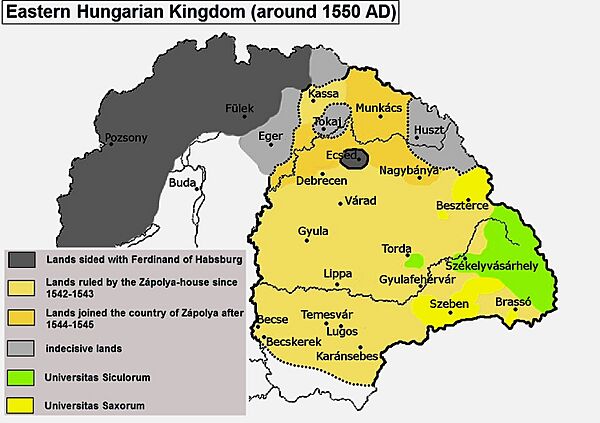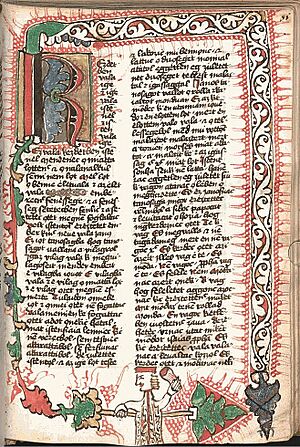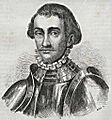Edict of Torda facts for kids
The Edict of Torda was an important law in the Eastern Hungarian Kingdom back in 1568. It allowed local communities to freely choose their own religious leaders, called preachers. This law was passed in a town called Torda on January 28, 1568. It was requested by Ferenc Dávid, a preacher for the ruler, John Sigismund Zápolya.
The Edict of Torda was a big deal because it was one of the first times a European country officially allowed a new and different Christian religion to exist. Even though it didn't give every single person the right to choose their religion, it was a huge step towards religious tolerance for its time.
Before this, the Catholic and Eastern Orthodox churches had lived side-by-side in Hungary for a long time. But new ideas, especially those seen as heresy (beliefs against official church teachings), were usually not allowed. For example, followers of Hussitism were forced out in the 1430s. Later, a law in 1523 ordered the persecution of Lutherans. However, this law was often ignored during the civil war that followed the Ottoman victory at the Battle of Mohács in 1526.
After the Ottomans took control of central Hungary in 1541, they allowed the young John Sigismund to rule the eastern lands. His mother, Isabella Jagiellon, helped him rule at first. In the 1540s, the local assemblies, called Diets, agreed that the Three Nations of Transylvania (Hungarian nobles, Transylvanian Saxons, and Székelys) could manage their own affairs. The Saxons decided that religion was one of these affairs and started the Reformation in their towns in 1544–1545. By 1557, the Diet officially allowed Catholics and Lutherans to exist together.
John Sigismund began ruling on his own after his mother died in 1559. He was very interested in religion and held many debates between different Protestant groups. He changed his own faith several times: from Catholicism to Lutheranism in 1562, and then to Calvinism in 1564. His doctor, Giorgio Biandrata, and preacher, Ferenc Dávid, convinced him to allow discussions about the Trinity (the idea of God as three persons). John Sigismund accepted their Antitrinitarian views in 1567.
The Edict of Torda was passed at the next Diet. It famously said that "faith is the gift of God" and made it illegal to persecute people for their religious beliefs. In practice, the edict officially recognized four main Christian groups: Catholic, Lutheran, Calvinist, and Unitarian. Later, during the rule of John Sigismund's successor, Stephen Báthory, new religious changes were stopped. But religious tolerance remained a special feature of the Principality of Transylvania in Early modern Europe.
Contents
A Look Back: Religious Changes
The Catholic Church faced big challenges in the Kingdom of Hungary in the late Middle Ages. New ideas, seen as against church teachings, started appearing in the late 1300s. In the 1430s, young students who had studied in Prague began teaching the ideas of Jan Hus. Hus had been condemned to death for his beliefs. Two followers of Hus even completed the first Hungarian translation of the Bible in the early 1430s. To stop these ideas, Pope Eugene IV sent a monk named James of the Marches to Hungary in 1436. Many Hussites who survived fled to Moldavia in 1439.
In the early 1520s, German townspeople in northern Hungary were the first to follow Martin Luther's ideas. Many German members of the court of Mary of Habsburg (wife of Louis II of Hungary) also supported the Reformation. However, most Hungarian nobles were against Lutheran ideas. They wanted to keep the support of the Pope against the Ottoman Empire. So, on April 24, 1523, the Diet of Hungary passed a law ordering the persecution and execution of Luther's followers across the kingdom.
The Ottoman Impact
The Ottoman Sultan Suleiman the Magnificent defeated the Hungarian army at the Battle of Mohács in 1526. King Louis II died while fleeing. Most Hungarian nobles then chose John Zápolya as their new king. But some powerful nobles chose Louis II's brother-in-law, Ferdinand of Habsburg. This led to a civil war that lasted almost 20 years.
Ferdinand and John later made a deal in 1538. They agreed that whoever lived longer would rule the reunited kingdom. However, John, who had no children, married Isabella Jagiellon. She gave birth to a son, John Sigismund, in 1540. John Zápolya died two weeks later, but not before getting his supporters to promise to protect his infant son's rule. They kept their promise and elected John Sigismund as king in Buda, which went against the 1538 agreement. This election caused Ferdinand's troops to invade again.
Suleiman took advantage of this new conflict and invaded Hungary again in 1541. He took control of the central part of the country. But he allowed John Sigismund to rule the lands east of the Tisza river as his vassal (a ruler who owes loyalty to a more powerful one). This created the Eastern Hungarian Kingdom. The local leaders of John Sigismund's realm accepted this and swore loyalty to the child king and his mother.
Steps Towards Tolerance

Eastern Hungary had long been a place where Catholic and Eastern Orthodox churches met. These two churches usually co-existed peacefully. The civil war after the Battle of Mohács made it hard to enforce laws against Lutherans after 1526. Many people saw the Ottoman victory as a sign of God's anger, which helped the Reformation's ideas spread. John Zápolya became less willing to persecute Lutherans after the Pope removed him from the church for his alliance with the Ottomans in 1529. He even organized a public debate between Catholic leaders and a Lutheran preacher in Schässburg in 1538.
Between 1541 and 1545, the Diets in the Eastern Hungarian Kingdom confirmed an old agreement from 1437. This agreement, called the "Union of the Three Nations," became a basic law. It said that each of the three nations (Hungarian nobles, Saxons, and Székelys) could manage its own internal affairs. The Saxons considered religious matters to be internal affairs. So, their assembly ordered the Reformation to be introduced in their towns and villages in 1544–1545. Lutheran ideas also spread among the nobles from the 1540s.
The Ottoman rulers always allowed different monotheist religions to exist, following Islamic traditions. However, Christians and Jews had to pay a special tax. In 1548, the Ottoman governor of Buda even stopped Catholic leaders from persecuting a local Lutheran preacher. He said that everyone "should be able to listen to and receive the word of God without any danger." Some historians believe this order might have influenced the Edict of Torda.
Isabella was forced to give her son's realm to Ferdinand of Habsburg in 1551. In the same year, Lutheran members of the town council of Debrecen accused their pastor, Márton Kálmáncsehi, of heresy. He had denied the idea of Christ's real presence in the Eucharist. He had to flee, but a wealthy man named Péter Petrovics protected him.
After Ferdinand couldn't defend the eastern territories, the Diet convinced Isabella and John Sigismund to return in 1556. Petrovics, who was a strong supporter, soon started new religious debates between Lutheran and Calvinist clergy. In 1557, the Diet passed a law that some historians call the "founding document of religious tolerance" in John Sigismund's realm. This law officially recognized the Lutheran Church and urged Catholics and Lutherans to avoid violence. In the same year, Hungarian clergy in the Várad region accepted the Calvinist view of the Eucharist. Lutherans called them "Sacramentarians" for this. The next Diet confirmed the 1557 law but also outlawed the Sacramentarians in 1558.
Because we and our noble son, in response to the ardent pleading of the land's [E]states, have decided that everyone may keep the faith he desires, including the new and the old customs of worship, we have left matters of faith to their discretion, so that it may happen as it pleases [the Estates]. In this matter, however, no injustice shall be done to anyone.
John Sigismund, Dávid, and Biandrata
John Sigismund became the true ruler of the Eastern Hungarian Kingdom after his mother died on November 15, 1559. He had been raised Catholic but was very curious about religious ideas. He organized new debates between Lutherans and Calvinists in Mediasch in January 1560 and February 1561. His Lutheran chancellor, Mihály Csáky, asked both sides to write down their views. These writings were sent to important theological centers in the Holy Roman Empire for review. Their opinions were used when the Lutheran clergy adopted a new set of beliefs in 1562. John Sigismund soon changed from Catholicism to Lutheranism.
Meanwhile, a clergyman from Kolozsvár, Ferenc Dávid, became very important in developing Protestant ideas in John Sigismund's realm. He was elected the leader of the Hungarian Lutheran Church in 1557. Dávid tried to bring Lutherans and Calvinists together, but their views on the Eucharist were too different. Dávid's studies of Erasmus of Rotterdam and Michael Servetus made him question old beliefs and believe in the free choice of religion.
In the early 1500s, Erasmus had encouraged ordinary people to read the Bible. When he published a Greek version of the New Testament in 1516, he left out a verse from the fifth chapter of the First Epistle of John. This verse had always been seen as the main proof of the Trinity. Servetus read studies by Jewish scholars about the Trinity and believed this idea was the main thing separating Christianity from Judaism and Islam. He had to leave his home for his Antitrinitarian views and was later executed in Geneva in 1553.
Dávid was elected the leader of the new Reformed Diocese of Transylvania, which followed Calvin's teachings, in 1564. In the same year, John Sigismund changed from Lutheranism to Calvinism and made Dávid his court preacher. The Diet also recognized the Calvinist Church. Two years later, the Diet made a Romanian Calvinist pastor, Gheorghe of Sîngeorgiu, the head of the Romanian Church. The Diet also ordered Eastern Orthodox clergy who wouldn't become Calvinists to leave, but this order was never carried out.
John Sigismund made the Italian Giorgio Biandrata his doctor in 1563. Biandrata had left Italy and had questioned the divinity of Jesus Christ in the late 1550s. Calvin even called him a "monster." Under Biandrata's influence, Dávid adopted Antitrinitarian beliefs in 1565. Péter Melius Juhász, the Calvinist bishop of Debrecen, strongly criticized Dávid. But the most important citizens of Kolozsvár continued to support Dávid. They even banned preaching ideas that were different from his.
John Sigismund first supported Juhász, but his Antitrinitarian doctor had a strong influence on him. He allowed Biandrata and Dávid to hold a religious meeting in early 1567. This meeting adopted an Antitrinitarian belief, stating that God the Father was the only God. Many Calvinist priests left Kolozsvár, but more and more Hungarian nobles and townspeople accepted Dávid's views. Melius Juhász held his own meeting in Debrecen that adopted a Trinitarian belief. His supporters demanded that Dávid be executed for his beliefs.
The Edict of Torda
Dávid published several books in Latin and Hungarian in 1567 and 1568 to defend his ideas. His first Hungarian book, A Short Explanation of How the Antichrist Beclouded the Knowledge of the True God, said that giving up the idea of the Trinity was needed to bring about God's Kingdom. He argued that ordinary people couldn't understand complex religious terms like "person" and "substance" and still be saved. To defend the idea of religious freedom, he quoted advice from the Bible. He referred to the story where Gamaliel told judges to release the imprisoned Apostles. Gamaliel suggested that if their work was from humans, it would fail, but if it was from God, the judges "will not be able to stop" them. Dávid also mentioned the Parable of the Tares, where Jesus says that weeds in a wheat field should only be gathered and burned at harvest time.
Biandrata and Dávid convinced John Sigismund to accept their Antitrinitarian beliefs by the end of 1567. The king called a Diet, which met in Torda on January 6, 1568. At Dávid's strong request, the representatives of the Three Nations confirmed the tolerance laws that had been passed in 1557 and 1563 on January 28. A new law was passed that made sure both Anti-Trinitarian and Trinitarian beliefs could be freely preached in the country. The edict stated that "faith is the gift of God" and that faith "comes from hearing the message, and the message is heard through the word about Christ." The edict also forbade people from treating each other badly because of their religion.
His Majesty, our Lord, in whatever manner he—together with his realm [i.e. the Diet]—legislated in the matter of religion at the previous Diets, in the same manner now, in this Diet, he reaffirms that in every place the preachers shall preach and explain the Gospel each according to his understanding of it, and if the congregation like it, well, if not, no one shall compel them for their souls would not be satisfied, but they shall be permitted to keep a preacher whose teaching they approve. Therefore none of the superintendents or others shall abuse the preachers, no one shall be reviled for his religion by anyone, according to the previous statutes, and it is not permitted that anyone should threaten anyone else by imprisonment or by removal from his post for his teaching, for faith is the gift of God, this comes from hearing, which hearing is by the word of God.
The Edict of Torda didn't give every person the right to choose their religion. Instead, it focused on the right of local communities to choose their pastors freely. Also, it didn't include Eastern Orthodox Romanians, Jews, or Muslims. Still, the Edict of Torda was an amazing step for religious tolerance in the 16th century. It was the first law to officially allow a new, radical Christian group (Antitrinitarians) to exist in a European country. After the edict, many religious debates happened between Trinitarian and Antitrinitarian groups. John Sigismund favored the Antitrinitarian preachers, but on October 25, 1569, he said that religion could always be freely discussed in his realm.
What Happened Next
John Sigismund died on March 14, 1571. He had already given up the title of king of Hungary and started calling himself the prince of Transylvania. The Diet chose a powerful Roman Catholic nobleman, Stephen Báthory, to be the new ruler of Transylvania. Even though laws said clergy shouldn't attack priests of other religions, Báthory urged the Saxon preachers to speak out against Calvinist and Antitrinitarian beliefs. The Saxons did not obey him.
Báthory also wanted to stop the Reformation from spreading among Romanians in Transylvania. He made an Eastern Orthodox monk from Moldavia, Eftimie, their bishop on October 5, 1571. But he didn't stop the Calvinist leader of the Romanians. The Diet urged Báthory to respect the laws about the Romanian Church from John Sigismund's time. But the Serbian Patriarch of Peć ordained Eftimie as bishop in 1572 with Báthory's permission. In May 1572, the Diet passed a new law that stopped new religious changes. This law allowed the prince to investigate those who broke it with church authorities.
Dávid continued to preach new ideas, which caused problems with Biandrata. Dávid rejected infant baptism and the worship of Christ, which led to him being imprisoned in 1579. Still, religious tolerance remained a special part of the Principality of Transylvania. In 1588, the Diet even made a law that said serfs (farmers tied to the land) could not be forced to change to their lords' faith. The four officially recognized religions – Catholic, Lutheran, Calvinist, and Unitarian – continued to exist together.
The Eastern Orthodox Church was not officially "received" but its existence was recognized. Gabriel Báthory, who ruled from 1608 to 1613, freed Eastern Orthodox priests from feudal duties and ensured they could move freely. His successor, Gabriel Bethlen, confirmed this law in 1614. He also allowed the Jesuits to return to Transylvania and settled about 200 Anabaptist Hutterites (who were persecuted elsewhere in Europe) in the principality. He also gave special rights to Jews, including freeing them from having to wear the Star of David or other special signs.
The Edict of Torda influenced laws in the multi-religious Polish–Lithuanian Commonwealth. On January 28, 1573, their general assembly, called the Sejm, passed the Warsaw Confederation. This included an article about religious freedom. This article remained in force until the mid-17th century.
Images for kids
-
John Sigismund's realm around 1550, showing the three main parts of Hungary.








